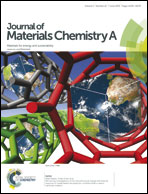High charge-capacity polymer electrodes comprising alkali lignin from the Kraft process†
Abstract
Advances in materials chemistry are necessary for low-cost energy storage to support energy generation from renewable sources and electric transportation. Renewable biopolymers, such as sodium lignosulfate (SLS), have attracted interest for electrodes when mixed with conducting polymers due to their higher charge-capacity and natural abundance. The availability of SLS is limited and will continue to decrease, while alkali lignin (AL), which accounts for 98% of lignin from paper-pulping, exhibits poor solubility in acidic electrolytes used for electropolymerization of conducting polymers. Here, we utilize organic acid solvents to overcome processing limitations in order to synthesize electrodes comprising polypyrrole (PPy) and SLS. Compared to PPy/SLS, electrodes containing PPy/AL exhibit an increase in capacitance from 312 F g−1 to 444 F g−1, and a decrease in relaxation time constant from 1.7 to 1 s. Furthermore, we showed that the electrochemical performance of PPy/AL electrodes could be further increased by incorporating AL with higher phenolic content that is obtained from an elevated-temperature, pH-driven fractionation process.


 Please wait while we load your content...
Please wait while we load your content...